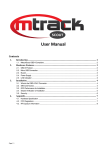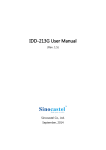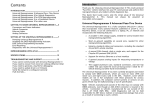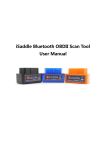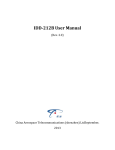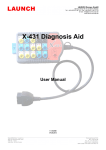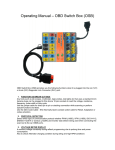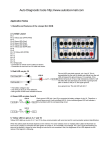Download MtrackScout User Manual Ver 2.0
Transcript
User Manual Contents 1. Introduction................................................................................................................................ 2 1.1. MtrackScout OBD-II Compliant ........................................................................................................... 2 2. Hardware Features .................................................................................................................... 2 2.1. 2.2. 2.3. 2.4. 2.5. 3. Installation .................................................................................................................................. 4 3.1. 3.2. 3.3. 3.4. 3.5. 4. OBD-II Protocol.................................................................................................................................. 2 Micro USB Connection ....................................................................................................................... 2 Buzzer............................................................................................................................................... 2 Power Supply .................................................................................................................................... 2 LED Indication ................................................................................................................................... 3 What is the OBD-II DLC Connector..................................................................................................... 4 SIM Card Access ............................................................................................................................... 4 GPS Performance for Installation ........................................................................................................ 5 Simple Verification of Installation......................................................................................................... 6 Security ............................................................................................................................................ 6 Appendix..................................................................................................................................... 7 4.1. Hardware Specification ...................................................................................................................... 7 4.2. FCC Regulations ............................................................................................................................... 7 4.3. RF Exposure Information ................................................................................................................... 8 Page | 1 1. Introduction The MtrackScout GPS Tracking Device is the most advanced and economical diagnostic device for communicating vehicle information to the GSM/GPRS networks. With an integrated high sensitivity GPS receiver, the MtrackScout provides the fundamental functions with optional advanced features for tracking light trucks and passenger vehicles in need of monitoring location, speed, and many other codes available on the OBD port of the vehicle. 1.1. MtrackScout OBD-II Compliant OBD-II is a standard that was created by SAE (Society of Automotive Engineers) in the early 1990s. However, some vehicles do not follow this standard. Therefore MtrackScout cannot guarantee the OBD-II performance of the MtrackScout with every vehicle. For more information about MtrackScout’s OBD-II compliance, please refer to MtrackScout OBD-II Compliance Guide document. 2. Hardware Features 2.1. OBD-II Protocol There are five signaling protocols that are permitted with the OBD-II interface. Most vehicles have been issued with only one of the protocols. The MtrackScout features a superior protocol detection algorithm that ensures the device connects reliably even to vehicles that do not fully conform to the OBD-II standards. The MtrackScout supports all legislated OBD-II protocols below: • • • • • J1850 PWM (Ford vehicles) J1850 VPW (GM vehicles) ISO9141-2 (Asian, European, Chrysler vehicles) ISO 14230-4 KWP ISO 15765-4 CAN (11/29 bit ID,250/500 Kbaud) 2.2. Micro USB Connection The Micro USB can supply power to the MtrackScout device for parameter setting or firmware upgrade purpose. When micro USB is connected to your laptop/PC and mains power is not applied, the OBD-II and GSM/GPRS functions will be turned off temporarily. This function is used by MtrackScout technical support staff. 2.3. Buzzer The internal buzzer of the MtrackScout can be configured to be triggered by any number of events (speeding, excessive idling, harsh braking or acceleration and RPM). The buzzer also indicates the operational status of the MtrackScout explained in section 3.5 of this manual. 2.4. Power Supply The MtrackScout device connects to the OBD-II SAE J1962 connector of the vehicle and draws power from the OBD port. No additional power cabling is required for operation. Ver 2.0 Page 2 2.5. LED Indication The following table describes the LED operation of the MtrackScout: LED Indicators Color Green LED Status Solid OFF Fast blinking Blinking every 10 seconds Description OBD Protocol not found OBD-II data transmission. Deep sleep mode OBD GPS Blue Solid OFF Blinking every 1 second Solid ON GPS power OFF GPS not fix GPS Location Fix GSM Red OFF Blinking every 1 second Blinking every 2 seconds Blinking twice every 2 second GSM Power OFF GSM no signal GSM registered GPRS connected Ver 2.0 Page 3 3. Installation MtrackScout is designed for easy Plug & Play installation. Just find the DLC connector of your vehicle and plug MtrackScout in to the port. 3.1. What is the OBD-II DLC Connector The OBD-II DLC connector is a standard connector for all vehicles which are OBD-II compliant. Almost all vehicles manufactured in 1996 or later are OBD-II compliant. The OBD-II DLC connector is shown below: The OBD-II DLC connector is most commonly found underneath the dashboard on the driver side. See the following figure for DLC location for most vehicles. Location #1-#3 is under the dashboard of the driver side. Location #4-#5 is on the dashboard instrument/gauge area. Location #6-#7 is near radio and climate controller. Location #8 is near the armrest and handbrake area. 3.2. SIM Card Access Remove the top cover of the MtrackScout by pressing the clips located on the side of the casing. Insert the SIM card into the SIM card holder. Please note that the security PIN must be disabled on the SIM card before inserting it into the MtrackScout unit. This is done my inserting the SIM card into any phone and navigating to the security settings menu and disabling the PIN code on the SIM card. Ver 2.0 Page 4 Top Cover SIM Card OBD LED GPS LED GSM LED Micro USB 3.3. GPS Performance for Installation The MtrackScout determines its position by communicating with Global Positioning Satellites (GPS). The accuracy of the GPS location will have a lot to do with the overall performance of the GPS receiver. The MtrackScout device has an internal GPS antenna and the following interior conditions may cause bad GPS reception: • • • • Your vehicle has a metallic window tint Your vehicle has a windshield mounted radio antenna Your vehicle has a solar reflective window The AX5 installation direction should be considered as well. Please see the following figure: Sky GPS Antenna Good for GPS reception DLC Connector Acceptable for GPS Bad for GPS reception The MtrackScout uses the latest GPS technology which accelerates GPS positioning by capitalizing on the periodic nature of GPS satellite orbits. GPS orbit predictions are directly calculated by the GPS receiver and no external aiding data or connectivity is required. Ver 2.0 Page 5 3.4. Simple Verification of Installation When the device is configured and first plugged into the OBD port. The MtrackScout will have some buzzer indications for basic function test. The user can simply to verify if the MtrackScout device is installed properly. Buzzer Indication Beep 1 time Description Device Power ON Beep 2 times OBD Protocol Connected Beep 3 times GSM/GPRS Connected Beep 4 times GPS Fix 3.5. Security Once the unit is installed the flashing LED lights might be visible due to the location of the OBD-II DLC connector on the dash board. If this is the case we suggest that the LED lights are covered / concealed by sticking a piece of black tape over the LED lights. • LED Lights are visible after installation. • Cover the LED lights with a piece of black sticky tape. • After applying the black sticky tape the LED Lights are no longer visible when active in the vehicle. Ver 2.0 Page 6 4. Appendix 4.1. Hardware Specification MtrackScout GSM/GPRS Specification GSM Module Quad band (850/900/1800/1900MHz) Communication SMS/USSD/GPRS /TCP/UDP GSM Antennas Internal Type GPS Specification GPS Receiver 50 Channels, L1 Band, C/A Code Sensitivity -159dBm Accuracy 2.5m CEP Assisted GPS Supported OBD-II Specification Supported Protocol ISO 15765-4 (CAN) ISO 14230-4 (KWP2000) ISO 9141-2 vehicles) (Asian, European, Chrysler SAE J1850 VPW (GM vehicles) SAE J1850 PWM (Ford vehicles) Electrical Characteristics Power Source 8-20 VDC Power Consumption Sleep Deep Sleep Operation al 140 mA @ 12VDC (Average) 18 mA @ 12VDC <2 mA @ 12VDC Mechanical Specification Dimension 50 x 46 x 25 mm OBD Connector SAE J1962 Type A Weight 54g (Include OBD Option) Environmental Characteristics Operation Temperature -25 ~ +70°C Storage Temperature -40 ~ +85°C Humidity 5 ~ 95% 4.2. FCC Regulations • This device complies with part 15 of the FCC Rules. Operation is subject to the following two conditions: (1) This device may not cause harmful interference, and (2) this device must accept any interference received, including interference that may cause undesired operation. Ver 2.0 Page 7 • This device has been tested and found to comply with the limits for a Class B digital device, pursuant to Part 15 of the FCC Rules. These limits are designed to provide reasonable protection against harmful interference in a residential installation. This equipment generates, uses and can radiate radio frequency energy and, if not installed and used in accordance with the instructions, may cause harmful interference to radio communications. However, there is no guarantee that interference will not occur in a particular installation. If this equipment does cause harmful interference to radio or television reception, which can be determined by turning the equipment off and on, the user is encouraged to try to correct the interference by one or more of the following measures: Reorient or relocate the receiving antenna. Increase the separation between the equipment and receiver. Connect the equipment into an outlet on a circuit different from that to which the receiver is connected. Consult the dealer or an experienced radio/TV technician for help. Changes or modifications not expressly approved by the party responsible for compliance could void the user’s authority to operate the equipment. 4.3. RF Exposure Information This device meets the government’s requirements for exposure to radio waves. This device is designed and manufactured not to exceed the emission limits for exposure to radio frequency (RF) energy set by the Federal Communications Commission of the U.S. Government. This device complies with FCC radiation exposure limits set forth for an uncontrolled environment. In order to avoid the possibility of exceeding the FCC radio frequency exposure limits, human proximity to the antenna shall not be less than 20cm during normal operation. Ver 2.0 Page 8








